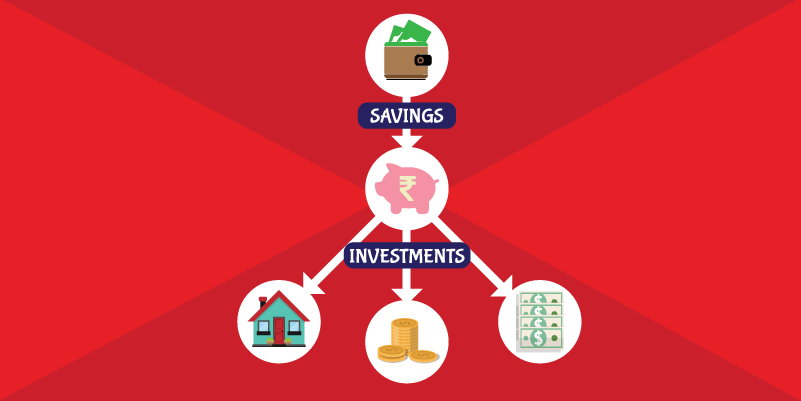Masters of illusions can make you see one thing as another until you figure out the trick.
Savings and investments could look like the same thing, but that’s the illusion. Here’s the example of a couple who didn’t know the difference.
Raman is a Government employee, drawing a modest salary. He leads a financially disciplined life. Every month, after accounting for the regular monthly expenses, Raman puts aside the surplus in his savings account. In addition to this, Raman also gives his wife, Priya, some money for the household expenses. After her expenses, Priya keeps the surplus cash in her wardrobe. While Raman and Priya are doing great by not spending away the surplus money, they are missing out on a lot.
They are simply saving money and not investing. Confused?
Many a time, people assume that saving and investing is one and the same and use these two terms interchangeably. However, there is a world of difference between the two terms.
Let’s see what the differences between savings and investments are, and how to save and invest money wisely.
Saving means putting aside any excess money, similar to what Raman and Priya were doing. So any excess of income over expenses is known as savings. Investing, on the other hand, is using the saved money and deploying it in various assets or financial products.
The difference between savings and investments
Timeframe: Savings are usually for a short time frame or for emergencies. However, investments can be for both, long or short period. Investments are generally made with a goal in mind. You can also invest in liquid funds for emergencies.
The way: How you save and invest is also different. You can save by keeping your money in a simple savings account, or in the form of cash. The age-old concept of savings involves keeping excess cash at home so that it’s useful in times of emergencies.
Investments are in the form of stocks, mutual funds, gold, real estate or fixed deposits. Investments should be made keeping in mind the risk and return preferences, goals and after doing thorough research on investment options.
Liquidity: Also, savings are more liquid and can be accessed at any time. For example, you can withdraw money from your savings account any time. However, this may not always be the case with investments. If you’ve invested in long-term bonds or in real estate, it may not be easy to liquidate your investment. However, investments such as bank deposits and mutual funds may entail faster liquidity.
Returns: The biggest difference between savings and investments is the amount of return you receive in exchange for a given level of risk. Savings have a negligible amount of risk. However, saving does not give you any return or income. On the other hand, investment options are capable of giving you an income. For example, if you invest in mutual funds, you can get good returns over a long period of time. However, investments carry risk.
In the above example, the amount you invest in mutual funds may move up or down depending on the market. The power of compounding also shows its magic on investments. But this is not the case with savings, as cash does not multiply by itself. In short, savings carry low risk and low return, whereas investments carry higher risks and high return.
So how much should one save and how to invest?
There is a fixed or ideal proportion of savings which one should invest.
You must always save all the income left after meeting your expenses. It is recommended not to burn extra cash in the form of unnecessary expenses. However, what is more important is the amount of savings which you invest.
It is advisable to invest at least 90%-95% of your savings, instead of keeping idle cash lying around. The remaining 5%-10% can be kept aside to meet your day to day expenses. Usually, people do not invest a large proportion of savings, citing reasons that this may be needed to meet emergency expenses which are of large magnitude. While it is important to keep aside money for emergencies, you can still put aside enough to invest.
To meet emergencies, you can do one of the following things –
(1) Set up an emergency fund which can cover at least 6 months of expenses, and
(2) Invest a proportion of total investments every month in liquid instruments which can yield you higher returns than a savings account and are also easy to liquidate.
Although it is recommended to invest almost all of what you save, investing just for the sake of investing does not make financial sense. Your investments should be based on your goals and commitments.
In the case of Raman and Priya, they should make a list of critical goals such as their children’s education, children’s marriage, their retirement etc., and invest accordingly. Also, the nature of investments depends on the risk-return profile of the investor and the time required to achieve the goals.
Poof, the illusion is all gone once you know the trick.
YOU MAY ALSO WANT TO: See the magic of compounding for yourself – Compound Interest Calculator
